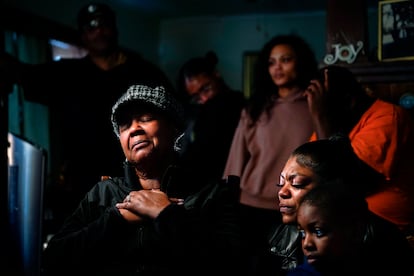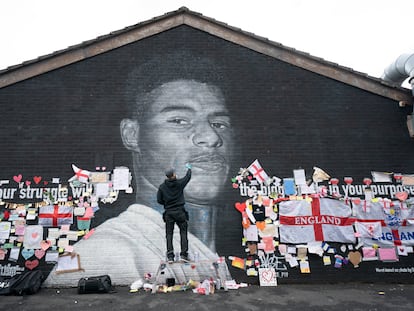Family members of Buffalo massacre victims: ‘Facebook and Twitch are also responsible for our pain’
The relatives of those murdered by the white supremacist Payton Gendron told EL PAÍS that they learned of the tragedy from the video that he live-streamed on social networks


Wayne Jones learned that his mother, Celestine Chaney, was one of 10 people killed in a racist massacre in Buffalo last Saturday, when he was emailed a photo of her lying on the floor, with an assault weapon pointing at her head. The murderer, Payton Gendron, live-streamed his shooting spree at the supermarket on the platform Twitch, and someone had taken a screenshot and sent it to Jones.
Jones always went with his mother to the Tops Friendly Market on Jefferson Avenue, he recalled with tears in his eyes, in an interview with EL PAÍS in Buffalo on Tuesday. On the day of the massacre, a leg injury prevented him from going with her. His Aunt Dee also cried as she remembered how she learned of her sister-in-law’s death. “I got a video that I opened without thinking. Now I can’t sleep at night. I think Twitch and Facebook are also responsible for our pain,” she said. Wayne Jones Jr., Celestine’s grandson, went further: “Seventy-two hours have passed and the video is still circulating, it’s appalling. It appears here and there, on someone’s [Facebook] wall, or in a random message. This is how the hatred behind the murder of my grandmother spreads. If we weren’t Black, this wouldn’t be happening.”

According to a spokesperson from Twitch, which is owned by Amazon, it took the company just two minutes to remove Gendron’s video from the platform on Saturday. But by the time the video was deleted from Twitch, it was already being shared on other networks, such as Reddit and Facebook.
On Wednesday, authorities revealed that the shooter, who was indoctrinated in white supremacist ideology by those same social networks, invited a group of users on the messaging system Discord to discuss his macabre plans just half an hour before getting into the car that would take him on the more than three-hour journey between his town, Conklin, in the south of New York state, and Buffalo. No one in that chat group notified the police. The New York attorney general’s office said Wednesday that it had launched an investigation into these platforms in connection with the mass shooting in Buffalo. “The fact that an individual can post detailed plans to commit such an act of hate without consequence, and then stream it for the world to see is bone-chilling and unfathomable,” said New York Attorney General Letitia James in a statement.
Chaney’s relatives were not the only ones to have been hurt by the terrible images of the shooting. Other family members of the victims expressed similar pain at an event on Tuesday to remember those killed. The memorial, which was held at a civic center near the grocery store, was attended by US President Joe Biden, who paid a special tribute to each of the 10 victims.
Biden defined Chaney as “a brain cancer survivor, churchgoer and bingo lover.” Geraldine Talley, 62, “was a friend to everybody, devoted mother and grandmother.” Pearl Young, 77, “loved singing, dancing, and her family.” Ruth Whitfield, 88, was a “beloved wife, mother, grandmother, great-grandmother who sang in the church choir.” While Margus Ardie, a 52-year-old school bus aide, was killed when he “went to buy snacks for weekly movie night with the family.”
Later, the mayor of Buffalo, Byron Brown, spoke to journalists in the area still cordoned off around the supermarket, which, four days later, is still closed. Brown paid tribute to Aaron Salter, a 55-year-old retired police officer who worked as a guard at the grocery store. He lost his life trying to stop Gendron, who was equipped with professional military equipment, including a bulletproof vest, and was detained by police before he could proceed with his plan to kill in other parts of the neighborhood.
The relatives of Andre Mackniel, 53, are comforted that at least the tragic events have put the spotlight on their community. The priest Tim Newkirk, who was accompanying Mackniel’s brother and niece, was hopeful that “the neighborhood will come out of this.” “We will not allow hatred, racism or terrorism to win,” he said. Taniqua Simmons, an anti-racist protester at the security perimeter of Wednesday’s event, was not as optimistic: “Many will think this neighborhood is a dangerous place, and it could become one, but I had never felt fear in my life until now. To overcome this sadness and anxiety, we will need tools that we, unfortunately, do not have.”

Buffalo is a tale of two cities, and this story is best seen from Main Street, which splits the city down the middle: to the east, the population is poor and mostly Black, and to the west, it is wealthier and white. It is a divide that can be felt across the city, which came to prominence at the beginning of the 20th century thanks to the steel industry, and was hit hard by the deindustrialization of the 1980s.
The victims of Saturday’s racist massacre are the descendants of those who came in search of fortune and settled in the east of the city. The killer chose Tops Friendly Market precisely because it served the area with the highest concentration of Black people in New York state. According to the local press, Gendron also considered other locations, such as a Walmart in Rochester and a shopping center in Syracuse.
“We all know each other here,” says Brenda McDuffie, who was the director of Buffalo Urban League, a non-profit organization dedicated to providing assistance to the city’s Black community. “That supermarket is the place where we would see one another. It is a part of our lives, and it has been taken from us by an individual who did not act alone, he had the support of others,” she adds, referring to those who, like the shooter, support the so-called “great replacement” conspiracy theory – a group that includes members of the Republican Party and popular radio and TV hosts. This white supremacist theory falsely asserts that white people are being replaced by non-white immigrants and minority groups as part of a master plan concocted by leftist elites.
McDuffie says one of her greatest achievements in her 20-year-leadership of Buffalo Urban League, was persuading Tops, a supermarket company that operates in the northeast of the country, that Jefferson Avenue was a safe place to do business. After the massacre on Saturday, no one is convinced of that anymore.
Tu suscripción se está usando en otro dispositivo
¿Quieres añadir otro usuario a tu suscripción?
Si continúas leyendo en este dispositivo, no se podrá leer en el otro.
FlechaTu suscripción se está usando en otro dispositivo y solo puedes acceder a EL PAÍS desde un dispositivo a la vez.
Si quieres compartir tu cuenta, cambia tu suscripción a la modalidad Premium, así podrás añadir otro usuario. Cada uno accederá con su propia cuenta de email, lo que os permitirá personalizar vuestra experiencia en EL PAÍS.
¿Tienes una suscripción de empresa? Accede aquí para contratar más cuentas.
En el caso de no saber quién está usando tu cuenta, te recomendamos cambiar tu contraseña aquí.
Si decides continuar compartiendo tu cuenta, este mensaje se mostrará en tu dispositivo y en el de la otra persona que está usando tu cuenta de forma indefinida, afectando a tu experiencia de lectura. Puedes consultar aquí los términos y condiciones de la suscripción digital.
More information
Archived In
Últimas noticias
Maduro pleads not guilty before the federal court in New York: ‘I am still the president of Venezuela’
A new test can detect Alzheimer’s from a finger prick
UN team enters Sudanese city of El Fasher after paramilitary massacre: ‘It’s like a ghost town’
A recipe for resistance: Indigenous peoples politicize their struggles from the kitchen
Most viewed
- Gilles Lipovetsky: ‘If you want to live better and fall in love, take Prozac, don’t look to philosophy’
- Alain Aspect, Nobel laureate in physics: ‘Einstein was so smart that he would have had to recognize quantum entanglement’
- Alvin Hellerstein, a 92-year-old judge appointed by Bill Clinton, to preside over Maduro’s trial in New York
- Why oil has been at the center of Venezuela-US conflicts for decades
- Maduro’s downfall puts China’s relationship with Venezuela to the test










































